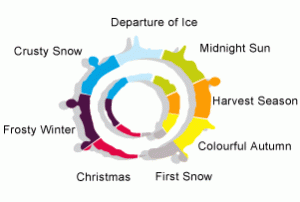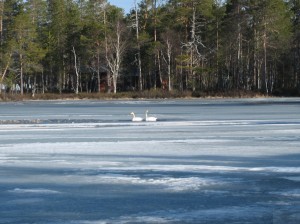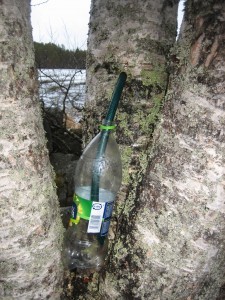 Winter lasts more than half a year in many places. Winter also means a long darkness and the blue light during day time and the lakes and rivers are covered with ice and snow for many months. But winter also brings light, because the white snow always makes even the tiniest lights brighter. At around 70 degrees north the sun is below the horizon for two months. During the winter period there are also possibilities to see the aurora borealis or northern lights. In summer you cannot see them because of the light. Summer is short. But then Lapland has up to two months of midnight sun – or nightless nights as they also are called.
Winter lasts more than half a year in many places. Winter also means a long darkness and the blue light during day time and the lakes and rivers are covered with ice and snow for many months. But winter also brings light, because the white snow always makes even the tiniest lights brighter. At around 70 degrees north the sun is below the horizon for two months. During the winter period there are also possibilities to see the aurora borealis or northern lights. In summer you cannot see them because of the light. Summer is short. But then Lapland has up to two months of midnight sun – or nightless nights as they also are called.
From the oldest times eight seasons were used by people living in Lapland to describe the cycle of mother nature. Here are the eight periods:
 Winter (December to April)
Winter (December to April)
Spring-winter (April and May)
Spring (May and June)
Spring-summer (June)
Summer (July and August)
Summer-autumn (August)
Autumn (September and October)
Autumn-winter (November)
There were good reasons for dividing time into eight seasons. The seasons followed the cycle of nature, which is constantly changing. The Lappish people learned that different tasks had to be done during the ever-changing cycle of the eight seasons.
Did you know that Lapland and the Arctic region on an average have more light than for instance regions near the equator? Thus the Lapland light makes the area a realm of light. And because of hours of twilight even the shortest day is not totally dark. As we move through the year, the Lapland light is in constant change. As winter changes to spring, the spring light changes everything around you.
The long white nights even urge many kinds of birds to migrate to these northern areas where they have more working hours than anywhere else in the world to bring the next generation to the world.
There are many kinds of birds in Lapland. Lapland is an eldorado for bird watchers. In many places there are bird-watching towers. The Lapland spring is a hectic time for fumigators who often come a long way to nest. I was surprised to find out that the time of arrival for the birds in Lapland in the spring does not vary too much from their time of arrival in the south of Finland. When I lived in the south of Finland I always thought of the arrival of the Common Gull (lat. Larus canus, fin. Kalalokki) meant that the spring was about to begin. But I have seen Common Gulls sitting on the ice in March looking for some leftovers from the ice-fishing people. And I can tell you the spring is really not in the nearest future; the ice is about 70 cm thick still.
 The same thing concerns the Swans (Cygnus cygnus). They migrate from Europe to Lapland in a time when there is only smaller parts of lakes or rivers open and free from ice. Then they spend time in the open water areas for weeks waiting for the ice to melt more and more around them.
The same thing concerns the Swans (Cygnus cygnus). They migrate from Europe to Lapland in a time when there is only smaller parts of lakes or rivers open and free from ice. Then they spend time in the open water areas for weeks waiting for the ice to melt more and more around them.
In spring time the Lappish people collect Birch sap (fin. mahla) from the Birch trees. Birch sap is drinkable and must be collected during a specific time of the year, at the break of winter and spring when the sap moves intensively up inside the trees before any green leaves have appeared on the tree. The Birch sap collection is done by tying a bottle to the tree, drilling a hole into its trunk and leading the sap to the bottle by a plastic tube. A small birch (trunk diameter about 15 cm) can produce up to 5 liters of sap per day, a larger tree (diameter 30 cm) up to 15 liters per day. The collection period is only about a month per year, as the sap later becomes bitter.
 The sap is often a slightly sweet, thin syrupy-watery liquid. The tree sap contains sugars (namely xylitol), proteins, amino acids, and enzymes. It is very healthy and keeps the flu away. It is also considered as antiseptic, anti-parasitic, anti-inflammatory and anti-itching treatment. Fresh birch sap is highly perishable; even if refrigerated, it is stable for only up to 2–5 days. You can of course also freeze it for later use.
The sap is often a slightly sweet, thin syrupy-watery liquid. The tree sap contains sugars (namely xylitol), proteins, amino acids, and enzymes. It is very healthy and keeps the flu away. It is also considered as antiseptic, anti-parasitic, anti-inflammatory and anti-itching treatment. Fresh birch sap is highly perishable; even if refrigerated, it is stable for only up to 2–5 days. You can of course also freeze it for later use.
The Birch sap collecting is a habit among people in the north of Europe and in Russia.
As the time of the nightless nights now are just about to start in Lapland, you can check the light in the city of Rovaniemi at any time of the day by opening this link with web cameras showing real time pictures in the city center. So even if you check the web camera in the middle of the night there will be light.

